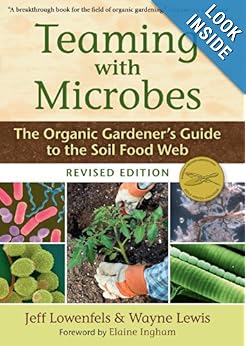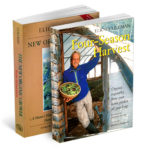Downloads
 Analyzing and Amending Your Soil Worksheet
Analyzing and Amending Your Soil WorksheetDownload the worksheet for this session. Space has been provided for those who would like to take notes. 🙂
Extra Resources
General Soil Amendment Recommendations
NOTE: These soil amendment recommendations are only general guidelines for those who have not had a professional soil test done and should be treated as such. Please use with care.
Initial application (applied prior to year 1)
For a soil initially of low fertility:
150 lbs/100 sq. ft. of compost or manure
10 lbs/100 sq. ft. of soft rock phosphate
10 lbs/100 sq ft. of greensand
For a soil initially of medium fertility:
100 lbs/100 sq. ft. of compost or manure
7 lbs/100 sq. ft. of soft rock phosphate
7 lbs/100 sq ft. of greensand
For an initially fertile soil:
50 lbs/100 sq. ft. of compost or manure
5 lbs/100 sq. ft. of soft rock phosphate
5 lbs/100 sq ft. of greensand
In all cases add sufficient limestone to maintain a pH of 6.5
Maintenance application (applied in years 2, 6, 10, and so on)
2.5 lbs/100 sq. ft. of soft rock phosphate
2.5 lbs/100 sq. ft. of greensand
Limestone as required
(Not necessary if a soil test indicates P, K, and trace minerals are adequate.)
Maintenance aplication (applied every other year)
50 lbs/100 sq. ft. of compost or manure
Credit: These general recommendations are adapted from those given by Eliot Coleman in his book the The New Organic Grower page 109.
Peaceful Valley Farm and Garden Supply Soil Testing Information
Order your soil analysis test here:
NPK Soil Analysis (with free PDF booklet)
Complete Soil Analysis (with free PDF booklet)
For more information on ordering your soil test call or email:
Phone: (888) 784-1722 Mon-Sat 8:30-5:00 PST
Email: helpdesk@groworganic.com
Peaceful Valley Online Organic Fertilizer and Amendment Store
Peaceful Valley Organic Fertilizer and Amendment Catalog (PDF)

Teaming with Microbes: The Organic Gardener's Guide to the Soil Food Web, Revised Edition
The 2011 Garden Writers of America Gold Award for Best Writing/Book proves soil is anything but an inert substance. Healthy soil is teeming with life -- not just earthworms and insects, but a staggering multitude of bacteria, fungi, and other microorganisms. When we use chemical fertilizers, we injure the microbial life that sustains healthy plants, and thus become increasingly dependent on an arsenal of artificial substances, many of them toxic to humans as well as other forms of life. But there is an alternative to this vicious circle: to garden in a way that strengthens, rather than destroys, the soil food web -- the complex world of soil-dwelling organisms whose interactions create a nurturing environment for plants. By eschewing jargon and overly technical language, the authors make the benefits of cultivating the soil food web available to a wide audience, from devotees of organic gardening techniques to weekend gardeners who simply want to grow healthy, vigorous plants without resorting to chemicals.
 The Soul of Soil - $25.00 The soil is the soul of the garden. This book provides sensible, focused, and passionate information for creating and preserving healthy soil. A must for all serious gardeners. |
Suggested Reading
 For a deeper look into this module read the following:
For a deeper look into this module read the following:
Four Season Harvest: p. 43-45
The New Organic Grower: p. 68-81; 111-118
8 Comments
Jan Johnson
November 19, 2015Hi Paul,
I received my Soil Analysis and did my computations. I have a question that I hope you can answer. My Calcium is high so I need to add Sulphur. My Sulphur is low so I need to add Sulphur. I am told I need 4 Lbs total for my Calcium problem and 2 Lbs for my Sulphur. Do I add 6 Lbs or just 4 (the highest of the 2 results).
I have the same issue with my trace elements. I need Zomite for Zinc-10 Lb, Manganese-10 Lb, Iron-6 Lb and Copper-6 Lb, Nothing for Boron. Do I really need 32 Lbs of Zomite or just 10 Lbs.
People tell me I can’t grow anything in the ground here. I hope to prove them wrong.
Paul
November 19, 2015Hi Jan! Did you do your test through Peaceful Valley (Grow Organic)? Let me know and we can get this figured out for you.
And yes, let’s prove them wrong!
Jan Johnson
November 19, 2015Yes. I did my test through Peaceful Valley.
Jan Johnson
November 19, 2015This is using your simple garden plan. I have 4 beds that will be 30″ wide and 20 ft long for a total of 200 square feet of garden space.
Jan Johnson
November 20, 2015I messed up. Calcium needs no amending. Sulfur is an add so my question is only for my trace minerals. Sorry.
Joelle
April 19, 2016How do I add the amendments to my raised beds? I still have garlic and other herbs (sage, oregano, thyme, mint) that have overwintered (under row covers) growing in some of them that I don’t want to pull out. Do I just try and work it in and around them?
Paul
April 21, 2016You could just try to work it in around them. There’s no problem with that. Or you can amend them in between your herbs and the next crop. If these are perennial herbs that you want to leave in there long term then definitely just scratch in the amendments around them.
Pam Brown
December 14, 2021In following the “Analyzing and Amending the Soil” video I did not see recommendations for source of calcium, iron, or boron; Azomite was suggested for other trace elements and phosphorous was mentioned later in the adding amendment section. Do you have suggestions?
I do not have the Peaceful Valley pamphlet since our soil tests were done (before knowledge of your program recommendations) through Western Labs in Idaho due to their particular study and recommendation for Giant Pumpkins (which are my personal reward for the rest of my work.) Admittedly this will take a bit of math to convert recommendations for quantities and for suggestions of the different needs of 8 different groups of plants to be grown. (A spreadsheet will be devised.) Born to Grow program recommendations will be used for reaching soil tilth goals.